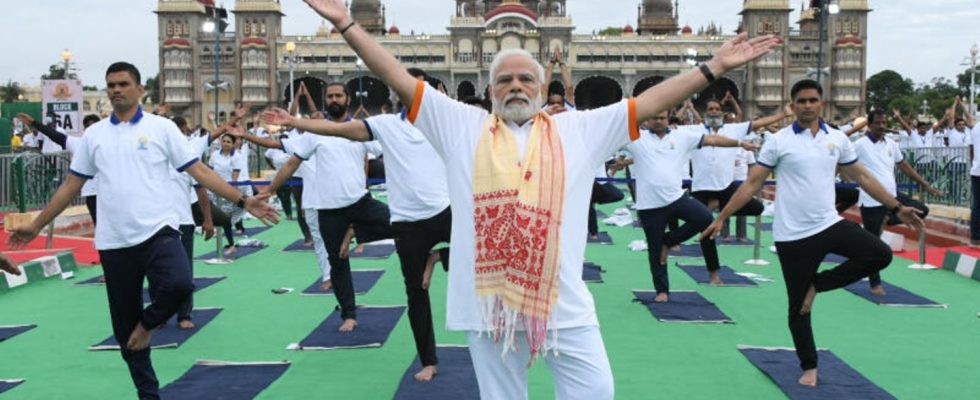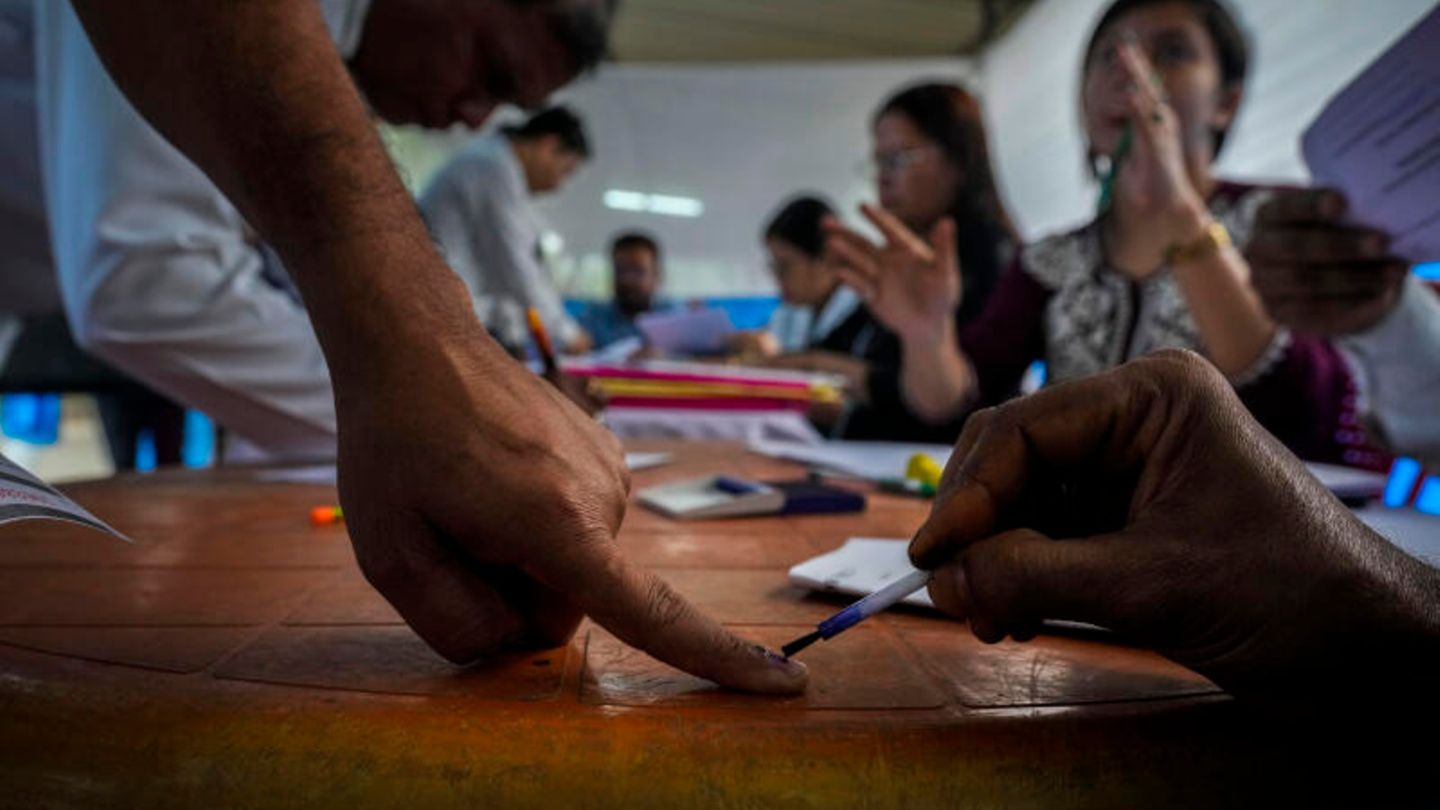All is well as long as you are Hindu! This is the doctrine that Prime Minister Narendra Modi has shaped India over the past decade. It is a given that the nationalist will remain head of government. The greatest election in history has begun. And that becomes a mere formality.
Hours before the first polling stations opened on Friday morning, people lined up to cast their votes. A superpower chooses. The winner will be a self-confident, retired nationalist who promises his supporters paradise on earth and despises those who think differently. No, we’re not talking about the USA. It’s about India. And this is probably one of the most important, most ignored elections in the world.
“Election” is a flexible term in this case – after all, it is already clear who will win the absolute majority. The question is what Narendra Modi, the old/new prime minister and cult leader will do with it.
The Hindu prince and his bollygarches
Never has an Indian head of government been more powerful, never less dependent on compromise. His BJP already rules with an absolute majority. But Modi wants more, more, more. This time there should be at least 400 parliamentary seats – a decisive step on the way to changing the constitution. As a scion of the Hindu fascist organization RSS, he follows the so-called Hindutva ideology: From the state of many peoples, languages and, above all, religions, he wants to form a unified nation under the political-cultural rule of the Hindu majority.
Despite growing discontent, especially among the poorer sections of the population, the fact that he succeeds is not a pipe dream. The masses hear and see what the Modi clique is presenting to them. In the current press freedom ranking by Reporters Without Borders, India ranks 161st out of 180, behind failed states such as Libya and Afghanistan. The social media accounts of journalists critical of the government are repeatedly blocked or their homes searched. Anyone who is too harsh on Modi can look forward to visits from the authorities – not excluding foreign media, as the BBC learned last year.
In his ten years in power, Modi has reportedly not held a single press conference, and his friends edit out negative headlines. Above all, media emperor Mukesh Ambani, the richest man in Asia. According to the media, the last independent broadcaster in 2022 fell to a Modi-friendly “bollygarch”. His hyper-rich cronies have enabled the prime minister to build a veritable cult of personality around himself. The idol: Modi, as a strict but caring father of the nation. But he makes no secret about who his favorite children are – and, above all, who aren’t.
Muslims in India – 200 million black sheep
Islam represents the largest religious minority in the country. Around 14 percent of Indians are Muslims, almost 200 million people. Nevertheless, they are not even a second priority for Modi. His BJP cronies now openly insult Muslims as “traitors to the nation.” This state-subsidized hatred can also be felt in everyday life.
According to Modi’s Hindi-first doctrine, cities were renamed with Muslim names, monuments were torn down, history books were rewritten and even the only Muslim-majority state of Kashmir was stripped of its special status and torn in two. According to media reports, the number of lynchings by armed mobs has also increased dramatically.
Most recently, the passage of a new immigration law made headlines. Accordingly, it should be easier for people who belong to a religious minority in Pakistan, Bangladesh or Afghanistan to apply for Indian citizenship – as long as they are not Muslims. At the same time, de facto Indians without papers should be deported more quickly. It is not unusual for poor Muslims, some of whom have lived in and especially in the countryside for generations, to be unable to identify themselves. A vicious circle: First they become stateless, then they are not allowed to apply for citizenship.
Modi’s lonely path to the top
There are good reasons why the boundaries between godfather state and father of the state are blurring in India. According to Survey by the US Pew Research Center 85 percent of Indians prefer autocratic rule. And it’s not as if Modi has to fear competition.
India soon Bharat?
Upcoming name change: These countries have already renamed themselves
The only “adversary” is named Rahul Gandhi. Although he is not the chairman, he is the face of the largest opposition party, the Indian Congress. The attractive man in his fifties has less to do with his much better-known namesake Mahatma than he did with gluttony, but he is at least the great-grandson of India’s first Prime Minister Jawaharlal Nehru. As a result of decades of nepotism, Gandhi’s supposed superiority is written all over his face. As a child of the political establishment, he seems out of time. Even if it were a head-to-head race, he would have no chance against the rhetorically superior, mass-appealing Modi and his grandfatherly charm.
Rahul Gandhi, the most famous face of the Indian National Congress
© Sanjeev Verma / Hindustan Times / Imago Images
Most recently, the opposition INDIA bloc even had to temporarily suspend the election campaign. Modi had frozen the funds of his opponents – because of alleged tax evasion. As the “Indian Express” writesSince Modi’s reign, 95 percent of investigations by the Enforcement Directorate, an agency tasked with cracking down on financial crimes, are said to have targeted the opposition. Corruption investigations against 23 out of 25 opposition politicians have reportedly been dropped after they defected to the BJP.
Essentially, India is facing “a referendum on Modi’s leadership over the last decade,” Milan Vaishnav, director of the South Asia program at the Carnegie Foundation, summed it up to the Japan Times. So is the subcontinent just playing democracy? Or has he always done this? “Indian democracy was primarily a gentlemen’s agreement. Freedom, equality and fraternity had nothing to do with it,” “Unherd” quotes the Indian economist Pranab Bardhan as saying.
By the time the dust settles on June 4th, India’s transformation will likely be complete: from the largest democracy to the largest electoral autocracy in the world.
Further sources: “Council on Foreign Relations“; “Unherd“; “Conversation“; “Foreign Affairs“; “Japan Times“; “Time Magazine“; CNN



